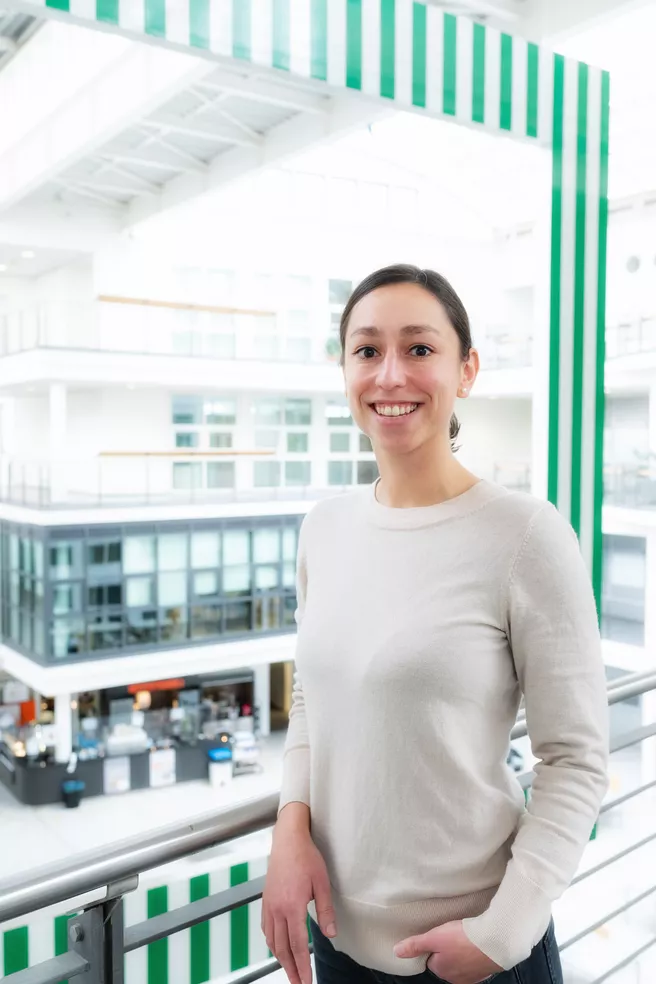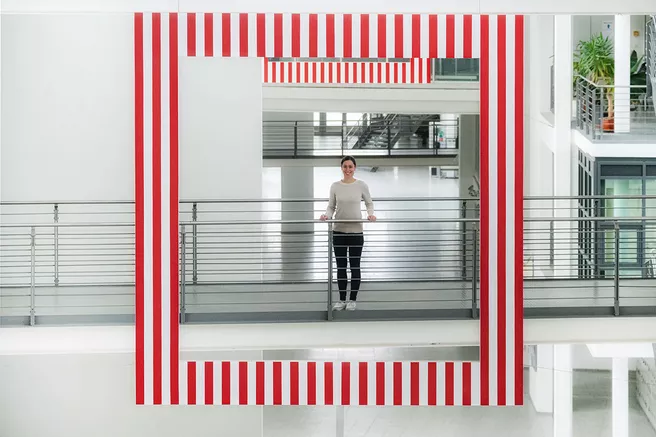The Corona crisis is giving a boost to digitalisation, says Caroline Adam. She heads the Future Work research group at the Chair of Ergonomics at the Technical University of Munich (TUM). However, home office alone is not the ideal case, she says, and some things are also falling by the wayside when it comes to communication.
Images: Thomas Linkel / Interview: Cornelia Freund
ED: Caroline, you completed your Bachelor's degree in "Scientific Foundations of Sport" at TUM and then decided to pursue a Master's degree in "Human Factors Engineering". What attracted you to the subject matter?
Caroline Adam: Both are very interdisciplinary courses that give insight into many different disciplines, which I found exciting. With the master's degree, I wanted to have a more technical focus and broaden my horizons. What I like about ergonomics is the human-centered approach. A good design of the socio-technical system is needed in all conceivable areas - people in their work system or in their interaction with products and processes.
Human-Centered Engineering and Design, which puts people at the center, is a central guiding principle at TUM. Where does the human dimension come into play?
Ideally at the beginning as a starting point, and then again and again during development. This ensures more successful design in the long term, which also explains the success of frameworks such as User-Centered Design or Design Thinking. Iterative human-centered or user-centered design is the keyword here - quite central in our discipline. This approach always pursues the goal of integrating people into the entire development process - from needs analysis to requirements analysis and development to evaluation. In ergonomics, we often also rely on the MTO concept, which assumes that the subsystems of people, technology, and organization are interdependent and must be optimized together.
The "Future Work" research group that you head is concerned with the future of the world of work, including disruption through digitalisation, but also through the Corona pandemic. The VUCA model (volatile, uncertain, complex, ambiguous), which describes the challenges facing companies, seems more relevant than ever. What change processes and practices have been visible since then?
Major changes, for example, industrial revolutions, but also wars and crises, have often been accompanied by new technologies in the world of work. Right now, digitalisation is unfolding its potential and, of course, we are in the midst of a very major upheaval in this context. Now, on top of that, there is also the pandemic. And that's what makes the current situation so exciting: a technical innovation, digitalisation, meets a crisis - the COVID19 pandemic. From one moment to the next, we were existentially dependent on the possibilities that had existed for some time due to digitalisation, especially during the lockdowns. This makes the current time more volatile, uncertain, complex, and ambiguous than ever. Having assumed, even independently of the pandemic, that we will have to cope in a "VUCA world", an extremely fast-moving world, in the future, we now have the opportunity to develop effective strategies for this. And, above all, to catch up in terms of digitalisation, which has progressed very slowly in many companies and organizations in recent years.
You have been working on the project "Good solutions for the future - lessons learned" since mid-2020. How is the research project designed?
We involved 34 companies and organizations from the primary, secondary and tertiary sectors in Bavaria, North Rhine-Westphalia, and Saxony, which have a strong presence in the respective regions and are heavily affected by the pandemic, e.g. manufacturing, public administration, and healthcare.
What insights did you gain from your investigations?
What was particularly striking was the sheer volume of different measures that were put in place across all sectors. The interplay of the many measures meant that organizations were very flexible and able to adapt quickly. Mainly, the measures introduced relate to hygiene protection and a flexibilization of the work location.
What impact does "physical distancing" have on people's working environment?
The effects are primarily negative for social interaction and team cohesion. Not only do people deal with the pandemic differently, but everyone has their phases when it's easier or harder for them. Most work content can generally be performed well remotely. So for a limited time, working exclusively in a home office is not a problem, but I think some of the negative effects from the pandemic-related home office will only become apparent over time. So we should neither demonize nor unreservedly welcome home office or remote working. With flexible working concepts, we can take advantage of the benefits of home office, such as positive effects on the work-life balance or the elimination of commuting times, and at the same time prevent the disadvantages of purely remote solutions, such as social isolation.
So what does it take to arrive well through the Corona crisis in the future of work?
The pandemic has changed communication in the workplace, such as access to information, the accuracy of information received, satisfaction with communication relationships with supervisors, colleagues, and employees. We collected data at several points during the pandemic, and it became apparent that completely moving organizations' communication to the digital is not so simple. For different communication partners, for vertical as well as horizontal communication, we have to make a conscious effort to ensure that communication makes the leap to digital, i.e. that we use the appropriate media for the respective content. For complex content, for example, we should choose rich media, i.e. video conferencing, and make targeted use of the advantages of synchronous and asynchronous communication. And we have to make sure that informal communication, which normally takes place spontaneously, also becomes digital - because there it has to be actively planned, which actually contradicts its nature.
About the person
Caroline Adam studied the bachelor's degree program Scientific Foundations of Sports at the Technical University of Munich and then the master's degree program Ergonomics - Human Factors Engineering.
Since 2017, she has been working as a research assistant and Ph.D. student at the Chair of Ergonomics. Her research focuses on the transformation of work in the context of digitalization as well as the possibilities of location-flexible working.
Links
Profile of Caroline Adam: https://www.mec.ed.tum.de/en/lfe/team/adam/
Future Work Research Group, Chair of Ergonomics, Department of Mechanical Engineering, TUM ED: https://www.mec.ed.tum.de/en/lfe/research/research-groups/future-work/
Project „Gute Lösungen für die Zukunft nutzen – COVID-19 Lessons Learned (COVID19LL)“: https://www.mec.ed.tum.de/en/lfe/forschung/projekte/covid-19-ll/
Video of the Project: https://youtu.be/mXmXWzHG8g4
Adam, Caroline; Bengler, Klaus; Brandl, Christopher; Nitsch, Verena; Ott, Gritt; Pütz, Sebastian; Schmauder, Martin: Work design measures and solutions for dealing with the COVID-19 pandemic: A systematic analysis of work in the primary, secondary and tertiary sectors in Germany. Journal of Occupational Science, 2021: https://mediatum.ub.tum.de/node?id=1633571&change_language=en
Adam, Caroline; Bengler, Klaus: It Takes Two to Tango: Communication at Work During the COVID-19 Pandemic. In: Proceedings of the 21st Congress of the International Ergonomics Association (IEA 2021). Springer International Publishing, 2021: https://mediatum.ub.tum.de/node?id=1613197


